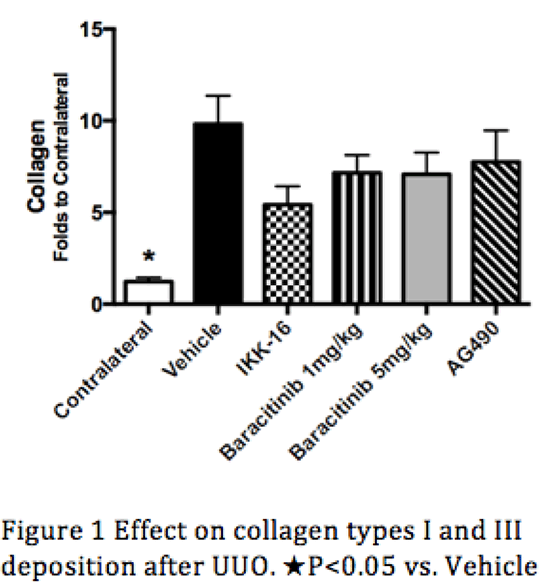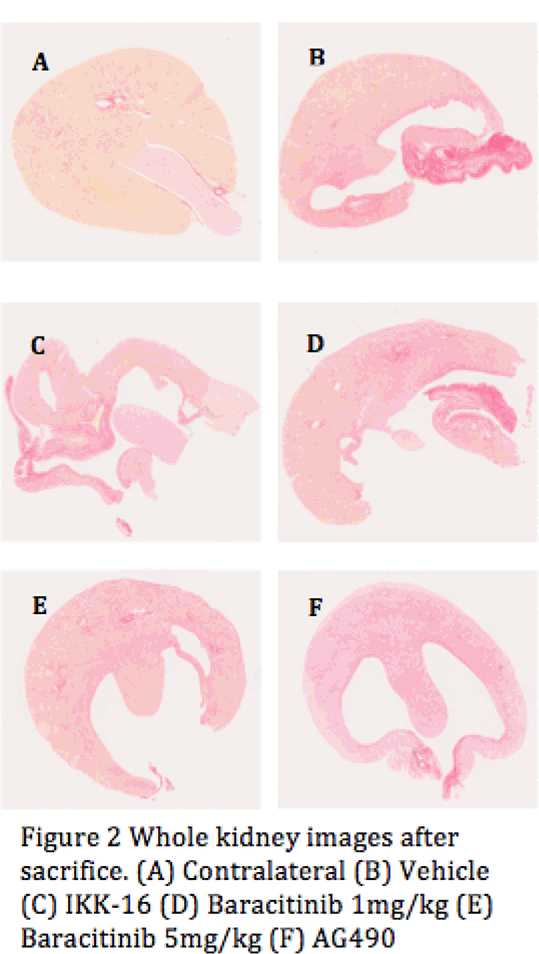| 163P London, UK Pharmacology 2016 |
The effect of Baracitinib on murine renal fibrosis induced by unilateral ureteral obstruction
Introduction: Acute kidney injury (AKI), an increasing problem in hospitalized patients, is defined as an abrupt deterioration of renal function in 48 hours or less (1). AKI is thought to be a strong risk factor for chronic kidney disease (CKD) and the subsequent development of renal fibrosis that normally accompanies CKD (2). Baracitinib is an oral JAK1 and JAK2 inhibitor currently in phase III clinical trials for the treatment of arthritis. The purpose of this study was to determine whether baracitinib attenuates murine renal fibrosis induced by unilateral ureteral obstruction (UUO), a model of AKI.
Method: 10 week old C57BL/6 mice were subjected to right ureteral ligation under anesthesia with a ketamine and xylazine cocktail. Mice were injected (i.p.) on days 1-13 with either: vehicle (10% DMSO 1mg/kg), IKK-16 (1mg/kg), baracitinib (1mg/kg or 5mg/kg) or AG490 (5mg/kg). Upon sacrifice (day 14) the kidneys were removed and stained with picrosirius red solution, anti-α-smooth muscle actin and anti-CD68 antibodies for collagen types I and III, myofibroblasts and macrophages, respectively. Data was analysed using a one-way ANOVA with a Tukey’s post hoc test, values of p<0.05 were deemed significant.
Results: Treatment with vehicle (i.p. n=4) resulted in a 9.8±1.55 fold increase in collagen deposition from contralateral. Administration of baracitinib (1mg/kg and 5mg/kg i.p. n=6) resulted in a 7.2±1.0 and 7.1±1.2 fold increase in collagen deposition, respectively (Figure 1). However, this reduction of collagen from vehicle to both the lower and higher doses of baracitinib was not significant (p>0.05). Although not significant, subtle decreases in collagen shown as red staining can be seen with the naked eye for both concentrations of baracitinib (Figure 2D and 2E) compared to vehicle (Figure 2B). Additionally, both doses of baracitinib did not significantly decrease deposition of myofibroblasts and macrophages.
Conclusions: Neither the low nor the high dose of baracitinib managed to successfully attenuate renal fibrosis in this model of murine UUO.
These data indicate that although baracitinib is efficacious in arthritis, due to the different mechanisms of the pathophysiology of AKI, baracitinib does not seem a likely candidate for the treatment for AKI. Nevertheless, further research must be conducted with larger n numbers to clarify these findings.
References
(1) Rahman MS and Smith MC (2012). American family physician 86(7): .631–639.
(2) Coca SG et al. (2012). Kidney International 81(5): 442–448.



